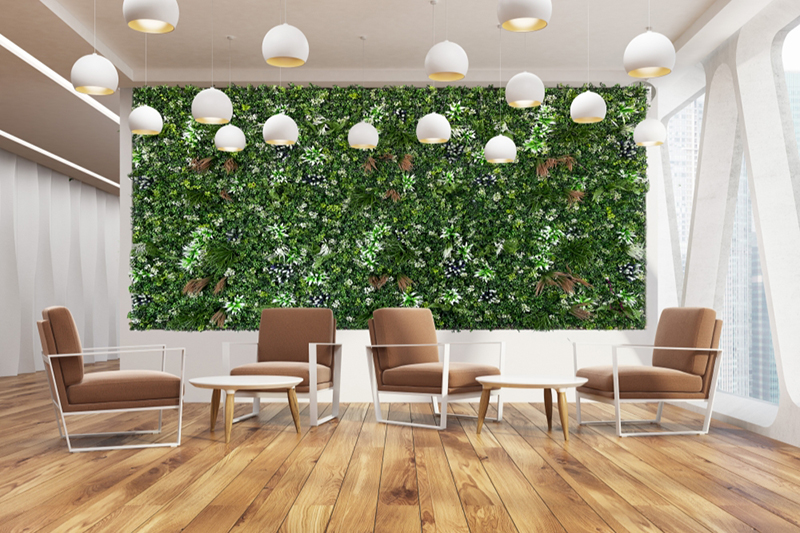In urban environments, rising temperatures due to climate change and the heat island effect have made cooling strategies a critical concern. 3D artificial vertical gardens have emerged as a sustainable solution, offering both aesthetic and functional benefits, including significant cooling effects. This article explores the mechanisms behind their temperature-regulating capabilities and their applications in various urban settings.
Vertical gardens reduce temperatures through a combination of evapotranspiration and shading. The plants in these gardens absorb sunlight and release water vapor through their leaves, a process known as evapotranspiration. This natural cooling mechanism can lower surrounding air temperatures by up to 6°C, depending on plant density and environmental conditions. Studies indicate that vegetation-covered walls can reduce indoor temperatures by 3–5°C compared to bare walls, significantly reducing the reliance on air conditioning systems.
The shading provided by vertical gardens also plays a crucial role in cooling. By blocking direct sunlight, the gardens prevent heat from being absorbed by building surfaces, which would otherwise radiate into interior spaces. This shading effect is particularly effective in urban areas, where buildings are often exposed to prolonged sunlight. The combination of evapotranspiration and shading creates a microclimate that is cooler and more comfortable for occupants.
The integration of vertical gardens into building facades offers a sustainable approach to urban cooling. In commercial buildings, vertical gardens can reduce energy consumption by lowering the demand for air conditioning. For example, in high-rise offices, plant-covered walls can create a buffer zone between the exterior environment and interior spaces, minimizing heat transfer. This not only improves thermal comfort but also reduces operational costs and carbon emissions.
In public spaces, vertical gardens can transform urban infrastructure into cooling corridors. Planting vertical gardens along streets, subway stations, or parking lots can mitigate the heat island effect, creating more pleasant environments for pedestrians. These installations also contribute to biodiversity and air quality, enhancing the overall livability of urban areas.
Unlike traditional cooling methods, such as air conditioning or reflective coatings, vertical gardens offer additional ecological and aesthetic benefits. While air conditioning systems consume significant amounts of energy and contribute to greenhouse gas emissions, vertical gardens provide passive cooling without relying on external power sources. Similarly, reflective coatings may reduce heat absorption but lack the environmental and visual advantages of green infrastructure.
However, the effectiveness of vertical gardens depends on factors such as plant selection, irrigation, and maintenance. Dense foliage and regular watering are essential to maintaining their cooling performance. Additionally, the structural integrity of the garden system must be considered to ensure long-term durability. Despite these challenges, vertical gardens represent a promising alternative to conventional cooling methods, offering a holistic approach to urban temperature management.
As technology advances, the design of vertical gardens for cooling is evolving. Researchers are exploring the use of smart irrigation systems and sensors to optimize water usage and plant health, ensuring maximum cooling efficiency. For instance, integrating vertical gardens with building management systems could allow for real-time adjustments based on temperature and humidity levels.
Furthermore, the development of hybrid systems combining vertical gardens with traditional cooling technologies is gaining traction. These systems could offer enhanced cooling while maintaining the aesthetic and ecological benefits of green infrastructure. In the future, vertical gardens may play a pivotal role in creating cooler, healthier, and more sustainable urban environments.
The cooling effects of 3D artificial vertical gardens represent a significant advancement in urban temperature management. By leveraging natural processes and innovative design, these installations offer a sustainable alternative to traditional cooling methods. As cities continue to grow, the integration of vertical gardens into architectural and urban planning will become increasingly vital, contributing to cooler, greener, and more livable spaces.

Contact: Amy
Phone: 86-15311787313
E-mail: info@foszmac.com
Whatsapp:86-15311787313
Add: Fengtai District, Dacheng Road, No.24 Building, Room 203, Beijing, China